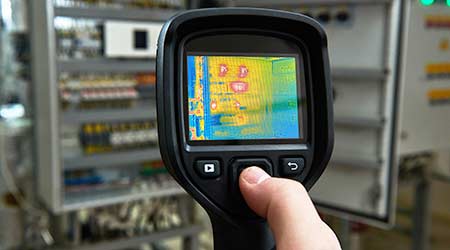 Infrared imaging systems are complex, so managers specifying new systems should not overlook the need for operator training.
Infrared imaging systems are complex, so managers specifying new systems should not overlook the need for operator training. Using Infrared Imaging to Detect Electrical Issues
Technology and application advances put more power in the hands of managers and technicians
Infrared imaging has been widely used in identifying electrical issues inside and outside the facility. For example, loose, crimped, corroded, and dirty connections in electrical equipment and circuits cause resistance to the flow of electricity. Any increase in resistance in an electrical circuit produces heat, which causes a further deterioration of the connections and produces even more heat. Allowed to progress long enough, this issue can lead to a failure of the circuit or worse.
Thermal images of electrical equipment can quickly identify areas where an abnormal buildup of heat in a circuit can occur, allowing technicians to schedule repairs before a failure occurs. By taking images regularly, such as once each year, technicians can identify issues that are developing slowly.
Technicians also can use infrared imaging to identify equipment, such as building transformers and electrical panels, that are overloaded. They can find faults in under slab electrical heating systems, allowing them to schedule repairs without causing extensive damage to the entire floor.
Eyes on HVAC
All HVAC systems involve the transfer of heat from one area or object to another, and thermal imaging systems are designed to identify heat transfer. They do it faster and more accurately than most other HVAC diagnostic techniques.
Thermal inspections of HVAC systems can identify coils that are partially blocked, have trapped air, or are operating at incorrect temperatures. Technicians can insect HVAC ductwork for leaks and blockages. They can inspect fire dampers that have failed in the closed position, can check pumps and motors for overheating bearings well before they fail, and locate leaks in piping located in walls and floor slabs.
Thermal scanners also provide good information technicians can use in developing a proactive maintenance program for HVAC equipment. Most system failures occur gradually over time. By monitoring and documenting system performance using thermal imaging, technicians can spot trends in equipment operation that eventually will lead to failures and unplanned downtime. The motor bearing failure, the plugged a coil, the failure in a motor control center all become evident as developing issues before they result in a system outage.
Related Topics:










